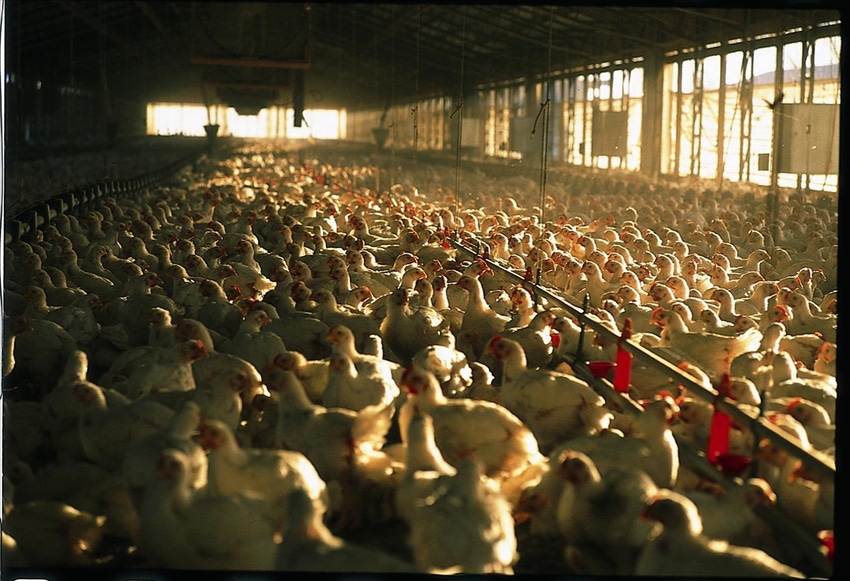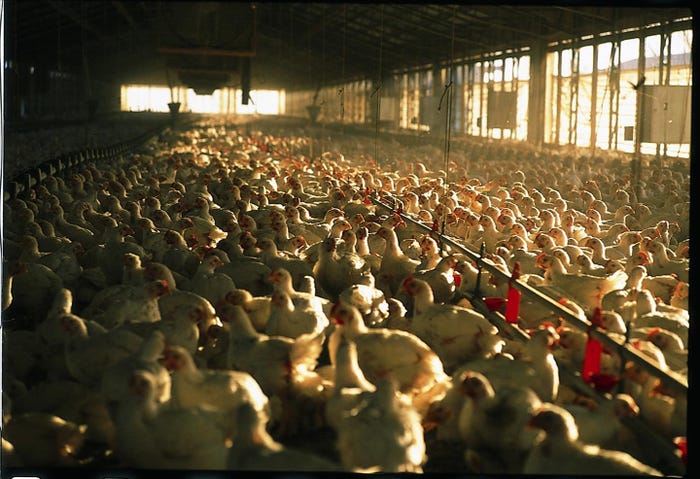N&H TOPLINE: Woody breast not linked to pathogens
Avian pathologists say altered muscle-repair systems 'likely to be involved' in woody breast. ALSO: New model for human digestion.

Three well-defined, degenerative breast diseases of broiler chickens — woody breast, white striping and deep pectoral myopathy — are not associated with infectious or pathogenic agents, nor do they present a threat to food safety, according to a new report by the American Association of Avian Pathologists (AAAP).
All three breast diseases have been seen in all breed crosses of broiler chickens as early as two weeks of age, with varying prevalence under a wide-range of slaughter weights, management, feeding and rearing systems, AAAP said.

The exact cause or causes of these conditions have not yet been identified. However, inadequate blood supply to the tissues — which may result from sudden exertion, overstretching and/or compression — as well as a lower rate of blood supply and a decline in metabolic waste-product removal (carbon dioxide and lactic acid) from the muscle fibers are “likely to be involved,” AAAP said.
Consumer preference for white meat and economic forces have led to a steady increase in the market weight of broiler chickens. Nevertheless, from a development standpoint, these birds are considered juveniles when harvested, the paper reports. In addition, this is a period when there's a high rate of cellular protein synthesis and accumulation, which leads to efficient animal growth, including the muscle tissue.
Muscle growth is a complex and highly regulated process — one that naturally involves both protein synthesis and degradation as rapidly growing muscle tissue undergoes degeneration and regeneration. Myopathies such as woody breast, white striping and deep pectoral myopathy emerge at different rates and stages when the extent of muscle damage exceeds the capacity of the repair systems to cope, AAAP said.
Research efforts and selection strategies are under way to reduce or prevent these conditions. In the meantime, broiler-meat processors are conducting comprehensive quality-controls and removing affected fillets to maintain product quality specifications.
The AAAP white paper, “Breast Muscle Abnormalities in Broiler Chickens,” was authored by Dr. S.F. Bilgili, poultry professor emeritus at Auburn University. To download a free copy, click here.
Human digestion
Last week, a group of fish nutritionists in Europe announced a project to develop an artificial gut system to study salmon digestion in order to better understand nutrient requirements of the fish.
Now, in a food engineering laboratory at the University of California-Davis (UC-Davis), a mechanical digestive system is churning out information that may help elucidate human digestion.
Designed and built by engineer and food scientist Gail Bornhorst, the novel device is providing clues that could help people make better decisions about when to eat, what to eat and how to prepare food to meet their own personal nutritional needs.
“The body is a food-processing plant with a digestive system we know very little about,” said Bornhorst, an engineer and assistant professor in the UC-Davis departments of biological and agricultural engineering and food science and technology. “We know a lot about the makeup of food as it goes in and comes out, but not much about what happens in between. Our goal is to quantitatively describe food breakdown, transport and absorption to optimize food quality and functionality.”
Why digestion matters. People want something from their food. Maybe it is to feel full and energized or for certain nutrients or extra protein. People can evaluate the properties in food — or trust the marketing and ingredients listed on a label — but, in many cases, it’s unclear how or if bodies absorb the nutrients, additives and molecules that are ingested.
“We know how a tomato-processing plant works because we can stick sensors inside the tanks,” Bornhorst said. “It’s not so easy with human digestion.”
Researchers are starting to find noninvasive ways to study digestion in live animals and humans using techniques such as magnetic resonance imaging, but the process is limited, costly and ethically controversial. Bornhorst’s lab is taking a different approach. Her research team members developed what they call the Human Gastric Simulator, a tabletop machine that mimics both the biochemical and physical conditions of a human digestive tract.
“We can add acids and enzymes to the ‘stomach’ to simulate gastrointestinal fluids,” Bornhorst said, pointing to a liquid-filled, plastic bag at the center of the device. With the flip of a switch, she turns on a network of slow-moving cranks and plastic rollers that compress the cavity of the bag. “That mimics stomach contractions.”
Bornhorst’s lab is testing a variety of fruits, vegetables and beverages to see how they move through the system. The researchers are also looking at how different cooking and processing methods such as boiling, steaming and frying influence the breakdown and transport of food.
“Turns out, how you prepare your food influences digestion quite a bit,” Bornhorst said. “We’re even seeing digestive differences depending on which variety of raw apple you eat.”
It’s too early for any sweeping conclusion, except maybe this: “Digestion is very complex,” Bornhorst said.
“There are a lot of moving parts and many variables, even person to person,” she said. “We’re working to quantify the fundamental transport processes to better understand things like nutrient release and absorption rates.
“When we have a more holistic understanding of human digestion, we can make more informed decisions about how to meet our nutritional needs,” Bornhorst added.
About the Author(s)
You May Also Like



